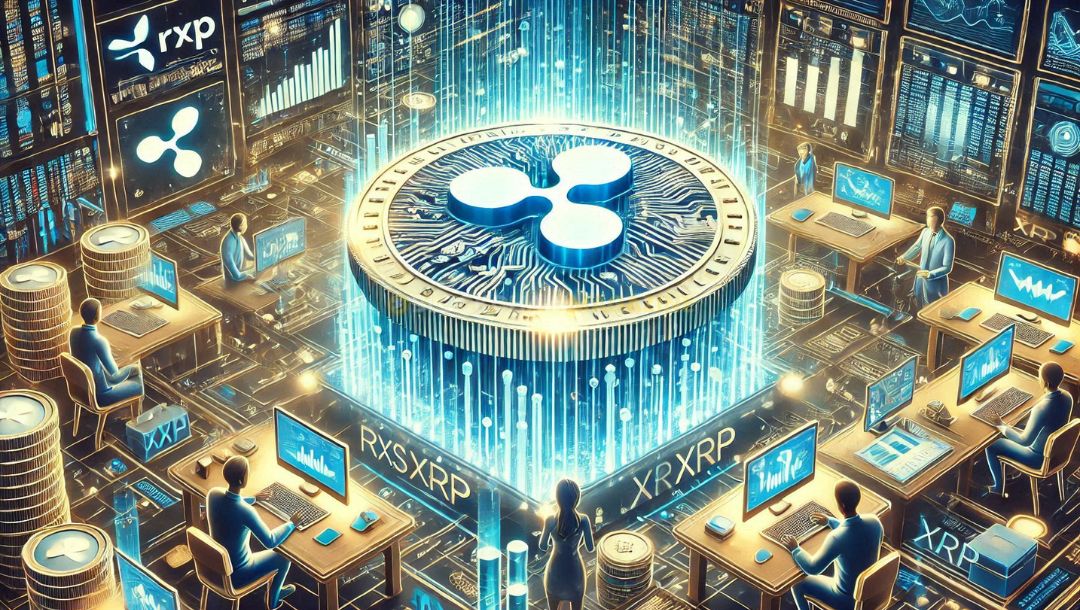XRP Blockchain Achieves New Milestone with 70 Million Ledgers Closed
The XRP blockchain just hit a big number—70 million ledgers closed. It’s a pretty big deal in the crypto world. This milestone is like a badge of honor for the XRP Ledger, showing how far it’s come since it started. With this achievement, XRP is making waves in the cryptocurrency market, attracting attention from both old and new investors. Let’s dive into what this means for XRP and its future in the blockchain space.
Key Takeaways
- XRP Ledger has closed 70 million ledgers, marking a significant achievement.
- The role of validators is crucial in the ledger closure process, ensuring transactions are verified.
- This milestone impacts the broader cryptocurrency market by boosting confidence in XRP.
- Technological advancements, like the introduction of Clio Version 2.2.1, enhance the XRP Ledger’s capabilities.
- Ripple’s strategic collaborations, such as with Archax, are expanding XRP’s use cases.
Understanding the XRP Blockchain’s Recent Milestone
What Led to the 70 Million Ledgers Achievement
The XRP Ledger has been a cornerstone in the crypto world, and reaching 70 million closed ledgers is a testament to its reliability and efficiency. Since its launch in 2012, the ledger has consistently demonstrated its ability to handle a high volume of transactions with ease. This milestone was achieved through a combination of technological advancements, strategic partnerships, and the unwavering support of its community.
- Continuous operation since 2012 without significant downtime.
- Scalability allowing for 1,500 transactions per second.
- Low transaction costs, making it attractive for high-frequency trading.
The Role of Validators in Ledger Closure
Validators play a critical role in the XRP Ledger ecosystem. They are responsible for confirming transactions and maintaining the integrity of the ledger. Unlike other blockchains that rely on energy-intensive mining, the XRP Ledger uses a consensus protocol that is both faster and more environmentally friendly.
- Validators ensure transaction accuracy and network security.
- Consensus is reached every few seconds, allowing for rapid ledger closure.
- The use of a Unique Node List (UNL) enhances trust and efficiency.
Impact on the Cryptocurrency Market
This achievement has a ripple effect across the cryptocurrency market. It not only highlights the robustness of the XRP Ledger but also boosts confidence among investors and users. As the ledger continues to grow, it attracts more institutional interest, paving the way for broader adoption.
The closing of 70 million ledgers isn’t just a number; it’s a reflection of the XRP Ledger’s ability to sustain and thrive in a competitive market. This milestone underscores its potential to revolutionize financial transactions globally.
Technological Advancements in the XRP Ledger
Introduction of Clio Version 2.2.1
The XRP Ledger recently introduced Clio Version 2.2.1, an API server designed to enhance the network’s efficiency. This update is optimized for HTTP and WebSocket API calls, making it easier for developers to interact with the XRP Ledger. This upgrade has significantly boosted the network’s accessibility and usage, attracting new investors and developers alike. The introduction of Clio Version 2.2.1 marks a pivotal moment in the XRP Ledger’s journey, reflecting its commitment to continuous improvement.
Enhancements in API Server Capabilities
With the new Clio version, the XRP Ledger has improved its API server capabilities, which means faster and more reliable data transmission. This is crucial for developers who rely on real-time data to build applications. The enhancements allow for better scalability and more efficient processing of transactions, ensuring that the network can handle increased demand without compromising performance.
Future Prospects for Developers
Looking ahead, the XRP Ledger’s technological advancements open up exciting possibilities for developers. The improved API capabilities and the introduction of Clio Version 2.2.1 provide a robust foundation for building innovative applications. Developers can now focus on creating solutions that leverage the XRP Ledger’s speed and low transaction costs. The future looks promising as the XRP Ledger continues to evolve, offering developers new opportunities to explore and innovate.
The XRP Ledger’s technological progress is a testament to its resilience and adaptability in the ever-changing crypto landscape. As it continues to innovate, it solidifies its position as a leader in blockchain technology.
These advancements not only enhance the ledger’s functionality but also contribute to XRP’s price surge, reflecting strong market momentum and potential growth with upcoming innovative upgrades.
Ripple’s Strategic Collaborations and Their Impact
Partnership with Archax for RWA Tokenization
Ripple’s partnership with Archax is a big deal, aiming to bring a ton of real-world assets onto the XRP Ledger. This move shows off XRPL’s strength in handling asset tokenization, which could make it a go-to platform for this kind of stuff. By teaming up with Archax, Ripple is not just expanding its reach but also making a mark in the world of finance by offering a solid blockchain solution for tokenizing assets.
Ripple’s collaboration with Archax is expected to bring hundreds of millions of dollars of tokenized real-world assets (RWAs) onto the XRP Ledger, reinforcing its position as a leading blockchain for RWA tokenization.
Ripple’s Recognition as a Top Fintech Company
In 2024, Ripple got a shoutout from CNBC and StatistaCharts as one of the top fintech companies globally. This recognition is not just a pat on the back; it’s a testament to Ripple’s influence and progress in the fintech world. Such accolades boost confidence among investors and the market, making Ripple a more attractive option for those looking to dive into the crypto space.
Ripple’s recognition as a top fintech company highlights its growing influence and success in the financial technology sector, enhancing its credibility and appeal to investors.
Influence on Institutional Interest
Ripple’s strategic moves have caught the eye of big institutions. By working with firms like Archax and getting recognized in the fintech space, Ripple is paving the way for more institutional interest. This isn’t just about getting more people on board; it’s about showing that Ripple is serious about its role in the future of finance. Institutions are starting to see Ripple as a reliable partner, which could lead to more collaborations and growth opportunities down the line.
Here’s a quick rundown of the impacts:
- Increased Credibility: Partnerships and recognitions boost Ripple’s reputation.
- Attracting Investors: More institutions are looking at Ripple as a viable investment.
- Market Expansion: Ripple’s strategic moves are opening doors to new markets and opportunities.
The Economic Implications of XRP’s Growth
Transaction Surge and Cost Reduction
XRP’s blockchain has been buzzing with activity, hitting a milestone of 88 million ledgers. This boom in transactions—108% growth in just the first quarter of 2024—shows how much interest there is in XRP. It’s not just about more transactions, though. The cost to send XRP has dropped significantly, by 45%, making it cheaper than ever to use.
Market Dynamics and Trading Volume
The trading volume for XRP has stayed pretty steady, especially on big exchanges like Binance and Bybit, which handle most of the action. Even though the trading volume through fiat currencies has dipped a bit, XRP is mostly traded against USDT now. This shift might be a sign of changing preferences among traders.
XRP’s Position in the Global Market
XRP is carving out its own space in the global crypto market. Despite some legal hurdles, it continues to be a major player, especially with recent technological updates and partnerships. Its speed and low cost make it attractive for both individual users and big institutions looking for efficient cross-border solutions.
Environmental and Efficiency Aspects of the XRP Ledger
Energy Efficiency and Carbon Neutrality
The XRP Ledger is often celebrated for its energy-efficient operations. Unlike Bitcoin’s energy-hungry proof-of-work system, XRP employs a consensus protocol that consumes minimal energy. This makes it one of the greenest cryptocurrencies around. The network’s design ensures that it remains carbon neutral, aligning with the global push for sustainable technology solutions. This commitment to environmental sustainability is not just about reducing carbon footprints; it’s about setting a standard for future blockchain technologies.
Scalability and Speed of Transactions
When it comes to speed and scalability, the XRP Ledger stands out. It can handle up to 1,500 transactions per second with settlement times of just 3-5 seconds. This is a game-changer in the crypto world where speed often dictates usability. With low transaction fees, often around $0.0002, and a mechanism that burns these fees, the ledger ensures that costs remain low while maintaining high efficiency. This scalability is crucial as the network grows, ensuring that it can handle increased loads without compromising performance.
Comparisons with Other Cryptocurrencies
Comparing XRP to other cryptocurrencies highlights its efficiency. Bitcoin, for instance, uses significant energy and has slower transaction times. Ethereum, while faster than Bitcoin, still lags behind XRP’s speed and cost-effectiveness. XRP’s consensus mechanism not only boosts speed but also enhances its environmental credentials. While other cryptocurrencies are working to improve their systems, XRP has already set a high bar for both efficiency and sustainability.
Exploring the Use Cases of the XRP Ledger
Applications in Cross-Border Payments
The XRP Ledger is transforming the way we think about cross-border payments. Traditional systems are often slow and costly, but with XRP, transactions can be completed in just seconds at a fraction of the cost. This speed and efficiency make it an attractive option for businesses and individuals alike. By eliminating the need for intermediary banks, XRP reduces fees and increases transparency, allowing users to track their transactions with ease.
Role in Decentralized Finance (DeFi)
The XRP Ledger is also making waves in the world of decentralized finance, or DeFi. By offering a platform that supports smart contracts and programmable payments, XRP is opening up new possibilities for financial innovation. Users can engage in lending, borrowing, and trading activities without relying on traditional financial institutions. This democratization of finance is empowering individuals and creating a more inclusive financial ecosystem.
Potential for NFT and Stablecoin Integration
Looking ahead, the XRP Ledger is poised to play a significant role in the integration of NFTs and stablecoins. With its low transaction costs and high scalability, XRP provides an ideal platform for the creation and exchange of digital assets. The introduction of Ripple USD (RLUSD), a USD-backed stablecoin, is just one example of how XRP is expanding its capabilities. As the demand for NFTs and stablecoins continues to grow, the XRP Ledger is well-positioned to meet the needs of this evolving market.
The XRP Ledger is not just about fast transactions; it’s about creating a financial system that is accessible, affordable, and efficient for everyone. As more use cases emerge, XRP is set to redefine what’s possible in the world of digital finance.
- Fast and low-cost transactions
- Support for smart contracts
- Integration with NFTs and stablecoins
For those interested in exploring blockchain tokenization on the XRP Ledger, focusing on real-world assets (RWA) is a great start. Discover how to create RWA tokenization solutions using various developer tools and APIs.
Challenges and Opportunities Facing the XRP Blockchain
Legal Issues with the SEC
The ongoing legal battle with the SEC looms large over the XRP blockchain. This lawsuit, questioning whether XRP should be classified as a security, has been a cloud over Ripple’s operations. The outcome of this case could significantly impact XRP’s future, either freeing it from regulatory shackles or imposing new constraints. It’s a waiting game that keeps investors on edge, as the verdict could swing the market dramatically.
Impact of Regulatory Changes
Regulatory landscapes are shifting worldwide, and XRP isn’t immune to these changes. As countries redefine their stances on cryptocurrencies, XRP must adapt to varying rules and compliance demands. This isn’t just about avoiding fines; it’s about maintaining legitimacy and trust in a skeptical market. Navigating these waters requires strategic foresight and flexibility.
Opportunities for Future Growth
Despite these challenges, XRP has a lot of room for growth. Here are some potential opportunities:
- Global Expansion: With new headquarters in Dubai, XRP is poised to tap into the Middle Eastern and Asian markets, which could lead to increased adoption.
- Partnerships with Major Banks: Collaborations with financial giants like Bank of America and Santander can open doors to new markets and use cases.
- Technological Advancements: Continuous improvements in API and developer tools keep XRP competitive and attractive to developers.
As XRP navigates these challenges and opportunities, its ability to adapt and innovate will determine its place in the crypto world. The road ahead is uncertain, but the potential for growth is undeniable.
Wrapping Up the XRP Ledger’s Journey
So, there you have it. The XRP Ledger hitting 70 million closed ledgers is no small feat. It’s like watching a marathon runner cross the finish line, but in the world of blockchain. This milestone shows how far the technology has come since its early days. With its low costs and speedy transactions, it’s no wonder XRP is gaining traction. But let’s not forget the challenges ahead, like the ongoing legal battles and regulatory hurdles. Still, the future looks bright for XRP. As it continues to grow and adapt, who knows what the next milestone will be? One thing’s for sure, though—it’s going to be an exciting ride.
Frequently Asked Questions
What is the XRP Ledger?
The XRP Ledger is a public blockchain that supports the digital currency XRP. It’s designed to be fast, energy-efficient, and cost-effective for processing transactions.
How many ledgers has the XRP Ledger closed?
The XRP Ledger has successfully closed over 70 million ledgers, marking a significant milestone in its operation.
What makes the XRP Ledger different from other blockchains?
Unlike many other blockchains, the XRP Ledger is known for its low transaction costs, quick settlement times, and environmentally friendly operations.
What is the transaction speed of the XRP Ledger?
Transactions on the XRP Ledger typically settle in 3-5 seconds, making it one of the fastest blockchain networks available.
How does the XRP Ledger impact the environment?
The XRP Ledger is designed to be energy-efficient and carbon-neutral, which means it has a minimal impact on the environment compared to other blockchains.
What are some uses of the XRP Ledger?
The XRP Ledger is used for a variety of applications, including cross-border payments, decentralized finance (DeFi), and potentially for NFTs and stablecoins.
Stay informed with daily updates from Blockchain Magazine on Google News. Click here to follow us and mark as favorite: [Blockchain Magazine on Google News].
Get Blockchain Insights In Inbox
Stay ahead of the curve with expert analysis and market updates.
latest from tech
Disclaimer: Any post shared by a third-party agency are sponsored and Blockchain Magazine has no views on any such posts. The views and opinions expressed in this post are those of the clients and do not necessarily reflect the official policy or position of Blockchain Magazine. The information provided in this post is for informational purposes only and should not be considered as financial, investment, or professional advice. Blockchain Magazine does not endorse or promote any specific products, services, or companies mentioned in this posts. Readers are encouraged to conduct their own research and consult with a qualified professional before making any financial decisions. The featured image used is just a creative depiction of the title and it does not intend to hurt sentiments of any person or institution. If it hurts anyone sentiments, please do not hesitate to reach out to Blockchain Magazine.

 Bitcoin
Bitcoin  Ethereum
Ethereum  XRP
XRP  Tether
Tether  Solana
Solana  USDC
USDC  Dogecoin
Dogecoin  Cardano
Cardano  Lido Staked Ether
Lido Staked Ether  TRON
TRON  Chainlink
Chainlink  Avalanche
Avalanche  Wrapped Bitcoin
Wrapped Bitcoin  Wrapped stETH
Wrapped stETH  Stellar
Stellar  Sui
Sui  Toncoin
Toncoin  Hedera
Hedera  Shiba Inu
Shiba Inu  WETH
WETH  Polkadot
Polkadot  LEO Token
LEO Token  Bitget Token
Bitget Token  Litecoin
Litecoin  Bitcoin Cash
Bitcoin Cash  Hyperliquid
Hyperliquid  Uniswap
Uniswap  Official Trump
Official Trump  USDS
USDS  Wrapped eETH
Wrapped eETH  Pepe
Pepe  NEAR Protocol
NEAR Protocol  Ethena USDe
Ethena USDe  Aave
Aave  Aptos
Aptos  Internet Computer
Internet Computer  Ethereum Classic
Ethereum Classic  Ondo
Ondo  Mantle
Mantle  WhiteBIT Coin
WhiteBIT Coin  Monero
Monero  Cronos
Cronos  POL (ex-MATIC)
POL (ex-MATIC)  Render
Render  Dai
Dai  MANTRA
MANTRA  Jupiter
Jupiter  Layer One X
Layer One X 




